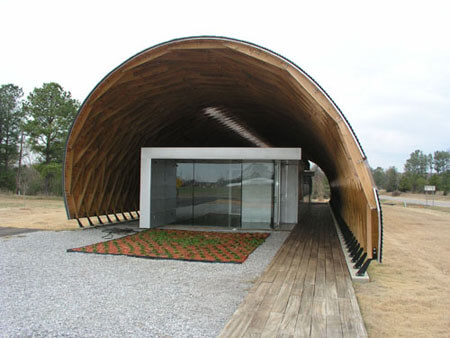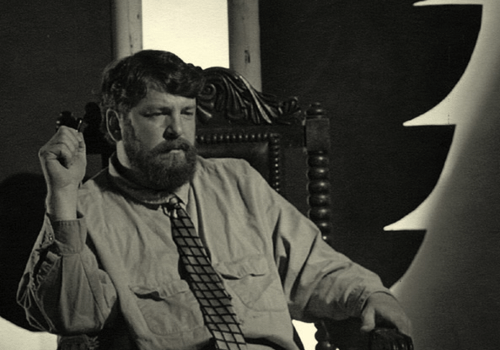Architecture and Morality
-
Posted on July 23, 2010
-
Architecture, Auburn University, Mockbee, Morality, Rural Studio, Sambo
I don’t know about you, but now that I’ve been out of school a few years, I’m finding it increasingly more difficult to not get frustrated by endless stacks of RFI’s, tight budgets, or impossible project schedules.
Sure these things are accepted parts of our profession, but at what point do you draw the line? When does the work we do cease being a shelter or a communal gathering place, and become a soulless shell of a building, waiting for yet another tenant move-in? Is it wrong of me to think that ever since the move into the “real world” that architecture has slowly been less about true design and more about the ever-present bottom line?
It’s during troubled economic times like these that I think about a different kind of architecture. You see, a few years back I was lucky enough to catch a talk sponsored by the local AIA chapter regarding a program out in the Alabama backwoods called the Rural Studio. Samuel “Sambo” Mockbee founded the Rural Studio as a living lab of architecture and design for Auburn University. 2nd Year and thesis students have been providing their own labor and using donated materials for going on 17 years now as they design, then build structures for the people that need them the most. Their client list is as far from a suit-wearing, real estate developer as one could get. Many of these people don’t have even the most basic of utilities at their disposal. For years now, the Rural Studio has been stepping to the plate and proving that there is a morality still alive and well in the work we do.
Sambo, a native son of Alabama, held the belief that architecture isn’t just about the all-white, multimillion dollar, designy pieces that land on the cover of Record or the in the New York Times. Architecture for him was about making your own corner of the world better than how you found it. That is something I think we should all remind ourselves from time to time. Since the program got off the ground, more than 80 projects have been completed in this very neglected part of the American South. Sambo and his students experienced the most pure form of design/build there ever was as they worked on small single family homes, community churches, and open air markets throughout the years. Sadly, Sambo left us in 2001 after a long fight against leukemia. His program still lives on, and students from Auburn University still venture into Hale County to take part in the Rural Studio.
Ever since I was first shown the incredible work of Sambo and his students I’ve secretly wanted to win the Mega-Millions and head off into the woods with them, doing work for a client base that truly appreciates the gift that architecture and design can provide. In the meantime, I’ll just have to keep Sambo’s story fresh in the back of my head as a reminder that there is more to what we do than paperwork and timecards.
P.S. The work of the Rural Studio has been the subject of a several documentaries, one of which is titled “Citizen Architect” and it’s PBS debut will be made on August 23rd. See the links below for further information about “Citizen Architect” and other interesting Rural Studio information, podcasts, etc.
- “Citizen Architect” Website
- PBS Site for “Citizen Architect” with a brief interview of the film’s Director and Producer
- Speaking of Faith – Rural Studio: An Architecture of Decency Podcast
- Speaking of Faith Slideshow featuring many of the Rural Studio projects
- An Essay by Sambo Mockbee


Introduction
“When an architect becomes tolerant of the elements which surround his craft then his creativity and freedom of expression are destined to fail.”
As all things evolve and transcend the elements of time and space so also there must occur adaptation to circumstance and continuity, as well as the cognizance of historical precedence. Presently the evolution of architecture has become so constrained by materials, politics, and building codes, all to the benefit of society, so have the changes in approach by the architect.
“Inner city buildings are best suited for target practice regardless of the size of the weapon because they are obviously good for nothing else.”
How many people, loss of life withstanding, would truly miss the Sears tower if it fell down or the Transamerica skyrise in San Francisco I dare say very few would go home and mourn and say it was a great loss more than likely it would be, “and another one bites the dust”. To the other end there would be great loss and sadness if the great pyramids of Egypt suddenly were a pile of dust or the Acropolis was tossed into the sea or Chartres Cathedral in France were to fall down. It is the things of the past which are of relevance and importance yet modern man has not grasped that concept.
This book and my personal writings and feelings are intended to awaken, offend and somehow instill thinking sensibly, practically, historically and conscionably into the architects repertoire of concerns and if it takes an attack on the existing mores and reactionary practices of present day architecture and its accepted practices then so be it. Granted there is a need to provide architectural services to society but do not call it architecture and do not presume that the architect is doing something useful or noteworthy. For the most part at present architects are merely material manipulation technicians or building mechanics and no different than an auto repair shop and anyone can hang out a shingle and call themselves an auto mechanic.
“Harvard takes perfectly good plums as students, and turns them into prunes. “
Frank Lloyd Wright
At this time probably, 90 percent of all registered architects are simply making a living to support themselves and their family by doing something they have been trained to do in the construction industry. Five percent are decorators catering to the whims of a client or the public four percent are to businessman and perhaps a generous one percent are architects. With these figures it is simple to deduce that 99 percent of all architecture is a pathetically juvenile and due to the media and self ordained architectural critics suddenly the woefully adolescent becomes publicly acceptable.
High-rise buildings are a prime example of childish self-indulgence and patronization to the whims of the financial influence on the architect or rather pseudo.
“Study nature, love nature, stay close to nature. It will never fail you”
Frank Lloyd Wright
The simplicity of high-rise architecture exhibits itself in the planetary and manufactured facade which is so conveniently supplied by the mechanization of industrial imperatives and marketing. It is quite elementary to say or instruct that the project will be key 80 stories tall 300 feet by 300 feet and needs a supporting frame so shoot it over to the engineer, contractor and decorator and suddenly its in Architectural Digest.
But as the interest of society in the placement of suburban housing grows it becomes necessary to provide adjacent shopping. This tends to fast paced and haphazard designs of “quick” structures to accommodate the expanding suburban dwellers and their penchant for proximate convenience.
At this time the number of vacant commercial or retail structures is numerous. As structures such the King Dome in Seattle, Washington, hotels in Las Vegas, “the Projects” in the inner city which were woeful disasters and a breeding ground for crime, are being imploded it becomes quite apparent how transient and temporary our present society truly is.
When past civilizations erected structures, whether they be villages, churches, mosques or fortresses the inten was that they stand for centuries.
“What is it of man that he sees fit to abandon his environment for temporary materialism?”
So as we continue on the same path of ignorance and lack of cognitive reason all that has been improperly conceived and pursued as well as jettisoned as unsound for civilized society will in turn rear its head to defy.
As man excitedly ventures forth with his obsession with technological advancement? And supposed improvement of the quality of life for humans he is doing so at the expense of that which maintains him. Also as he has obliterated and decimated our planet’s animal species now on the continents of Asia, North America, South America, Europe and Africa in the last 150 years, a short span in the history of the earth, he has also ignored history and created merely obtrusive mobile home parks which he calls cities and metropolises.
The architect should be a visionary and seer to guide and direct architecture and the habitat such that it is part of the score of the concerto which is earth and nature.